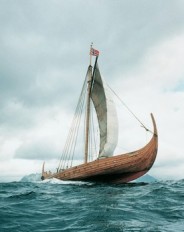 October 7, at a meeting of the Council for Northeast Historical Archaeology in St. John’s, Canada, Dr. Patricia Sutherland presented her research. It shows that wear grooves on whetstones from Tanfield Valley (Baffin Island) had very small parts of bronze, brass and smelted iron. This fact may seem rather natural: indeed, why blade-sharpening tools wouldn’t have traces of copper alloys? The point is that Dorset people, who are indigenous Arctic inhabitants, did not use these materials. Viking metalsmiths did.
October 7, at a meeting of the Council for Northeast Historical Archaeology in St. John’s, Canada, Dr. Patricia Sutherland presented her research. It shows that wear grooves on whetstones from Tanfield Valley (Baffin Island) had very small parts of bronze, brass and smelted iron. This fact may seem rather natural: indeed, why blade-sharpening tools wouldn’t have traces of copper alloys? The point is that Dorset people, who are indigenous Arctic inhabitants, did not use these materials. Viking metalsmiths did.
The whetstones came from four sites from northern Baffin Island to northern Labrador. These sites had been excavated earlier but the finds were not properly interpreted. In 1999 Sutherland noticed two pieces of cord stored at the Canadian Museum of Civilization. These were from Baffin Island and were not animal sinews twisted into cordage, a technique characteristic for Arctic hunters. They turned out to be yarn expertly woven in a way very similar to yarn produced by Viking women who lived in Greenland. More artifacts from a trove that included wooden tally sticks pointed to Norse travelers, too. [continue reading…]
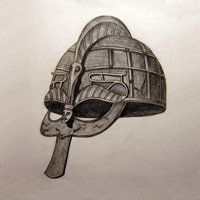
This blog is on Vikings and for Vikings. Warriors and traders from Nordic countries reached as far as North America, leaving lasting marks of their presence everywhere. In battle, Vikings feared nothing, eager to join Odin in his hall. They knew that valkyries chose who would die and become one of the einherjar in Valhalla.
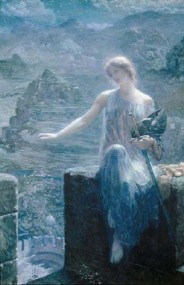 I’d like to thank Viking Rune for inviting me to write a guest post here on his blog. The subject that naturally sprang to mind for me was the Valkyries.
I’d like to thank Viking Rune for inviting me to write a guest post here on his blog. The subject that naturally sprang to mind for me was the Valkyries.
Norse mythology is filled with memorable stories and themes that still echo within our hearts and minds centuries after they were created. One part of those legends that has inspired me is the Valkyries. And I am not alone, the Valkyries have inspired everything from operas to video games, comic books to paintings, sculptures to episodes of Xena, Warrior Princess. So what do we know about the Valkyries?
Let’s start with the name. Valkyrie comes from the Old Norse valkyrja which means “chooser of the slain.” That’s fairly straightforward, except there is some confusion as to whether or not they choose who will fall in battle or just which of the fallen will go to Valhalla. Snorri Sturluson tells us in the Elder Eddas:
…these does Othin send to every battle; they ordain which men are doomed to death, and decide the victory.
But in the Volsunga Saga (the basis for Wagner’s epic opera series) Odin punishes Brynhildr (also called Brünnhilde) for allowing King Hjalmgunnar to die. This implies that Odin makes the choices and the Valkyries simply carry out his will. [continue reading…]

Find below the list of the most used Norwegian names from 1880 through 2010, according to the data provided by Statistics Norway (Statistisk sentralbyrå). Statistics for 2011 are not ready as yet, but in 2010 the most popular boys’ name in Norway was Lucas and the most popular girls’ name was Emma. In 2009 the most common Norwegian names were Mathias and Sara. The most used boys’ name in Oslo in 2010 was Mohammad.
The list is divided into top 50 male names and top 50 female names, giving the top 100 popular names in Norway for the last 130 yerars. Each name is provided with a short note as for its origin and meaning (ON stands for Old Norse). Check also the name day in Norway (in several cases other Scandinavian countries have different dates for the same names). [continue reading…]
Odin
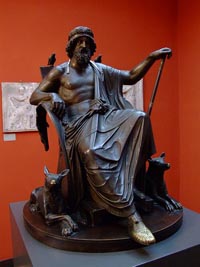 The supreme god of the Norse pantheon, the most worshipped among Viking gods. Odin corresponds to West Germanic Woden or Wotan. Etymology of his name points to poetic inspiration and shamanic ecstasy. As it seems, initially Odin was a patron of military unions and initiations, as well as a sorcerer god. With time he became a god of heaven and a major god among Æsir. Odin is served by two ravens Huginn and Muninn, as well as by two wolves, Geri and Freki. He owns an eight-legged horse Slepnir. He wears a broad-brimmed hat and a blue coat. Odin is one-eyed, because he sacrificed his eye at Mímir’s well. Odin bestows worthy poets with his mead of inspiration. As a sacrifice to himself, he hung on the world tree Yggdrasil, pierced by his spear Gungnir, in order to learn the wisdom of magical runes. One of Odin’s names is therefore the god of the hanged. In Asgard, the dwelling of Æsir, he has three halls: Gladsheim, Valaskjálf, and Valhalla. In Valhalla (‘Hall of the Slain’) Odin gathers the souls of warriors slain in battle, the Einherjar. Served by Valkyries, they feast there and prepare for the final battle of Ragnarök. [continue reading…]
The supreme god of the Norse pantheon, the most worshipped among Viking gods. Odin corresponds to West Germanic Woden or Wotan. Etymology of his name points to poetic inspiration and shamanic ecstasy. As it seems, initially Odin was a patron of military unions and initiations, as well as a sorcerer god. With time he became a god of heaven and a major god among Æsir. Odin is served by two ravens Huginn and Muninn, as well as by two wolves, Geri and Freki. He owns an eight-legged horse Slepnir. He wears a broad-brimmed hat and a blue coat. Odin is one-eyed, because he sacrificed his eye at Mímir’s well. Odin bestows worthy poets with his mead of inspiration. As a sacrifice to himself, he hung on the world tree Yggdrasil, pierced by his spear Gungnir, in order to learn the wisdom of magical runes. One of Odin’s names is therefore the god of the hanged. In Asgard, the dwelling of Æsir, he has three halls: Gladsheim, Valaskjálf, and Valhalla. In Valhalla (‘Hall of the Slain’) Odin gathers the souls of warriors slain in battle, the Einherjar. Served by Valkyries, they feast there and prepare for the final battle of Ragnarök. [continue reading…]
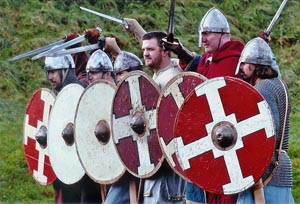 For defense, Vikings used large circular shields. Usually, the size of the Viking shields varied between 30″ and 36″ (75 – 90 cm). The shield excavated at a Viking fortress Trelleborg (Denmark) in 2008 was 33,5″ broad. No less renowned are shields from Gokstad Viking ship burial (Norway). With the end of the Viking Age the traditional circular shape was replaced by Continental kite shields with elongated bottom edge that ensured more protection for legs. Viking shields were used as the means of defense in battle, but for ship crews they also functioned as protection from waves and the wind, being fastened to gunwales (the upper edge or planking of the side of a Viking longboat). [continue reading…]
For defense, Vikings used large circular shields. Usually, the size of the Viking shields varied between 30″ and 36″ (75 – 90 cm). The shield excavated at a Viking fortress Trelleborg (Denmark) in 2008 was 33,5″ broad. No less renowned are shields from Gokstad Viking ship burial (Norway). With the end of the Viking Age the traditional circular shape was replaced by Continental kite shields with elongated bottom edge that ensured more protection for legs. Viking shields were used as the means of defense in battle, but for ship crews they also functioned as protection from waves and the wind, being fastened to gunwales (the upper edge or planking of the side of a Viking longboat). [continue reading…]
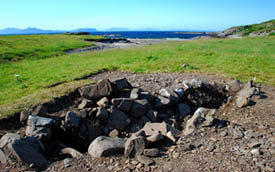 Stunning archaeological find was made last month in Scotland. A Viking ship burial, which is about 1,000 years old was unearthed on the Ardnamurchan peninsula. It was the grave of a chieftain buried in a rather small vessel (about 16ft) as compared to famous Gokstad or Oseberg ship burials in Norway or Sutton Hoo grave ship of the Anglo-Saxon king Raedwald in Suffolk. However, the Ardnamurchan find is of utmost importance. It is the first intact Viking ship burial find on the British mainland ever. It yielded the remains of a high-ranking warrior with a shield on his chest, his sword and spear by his side. The sword hilt was decorated. The burial also contained axe, knife, bronze ring pin from Ireland, whetstone from Norway, tip of a drinking horn and several iron fragments that are still to be identified. About 200 rivets were also found: all that remained from the boat. It had been filled with rocks, which seems to be on purpose. [continue reading…]
Stunning archaeological find was made last month in Scotland. A Viking ship burial, which is about 1,000 years old was unearthed on the Ardnamurchan peninsula. It was the grave of a chieftain buried in a rather small vessel (about 16ft) as compared to famous Gokstad or Oseberg ship burials in Norway or Sutton Hoo grave ship of the Anglo-Saxon king Raedwald in Suffolk. However, the Ardnamurchan find is of utmost importance. It is the first intact Viking ship burial find on the British mainland ever. It yielded the remains of a high-ranking warrior with a shield on his chest, his sword and spear by his side. The sword hilt was decorated. The burial also contained axe, knife, bronze ring pin from Ireland, whetstone from Norway, tip of a drinking horn and several iron fragments that are still to be identified. About 200 rivets were also found: all that remained from the boat. It had been filled with rocks, which seems to be on purpose. [continue reading…]
